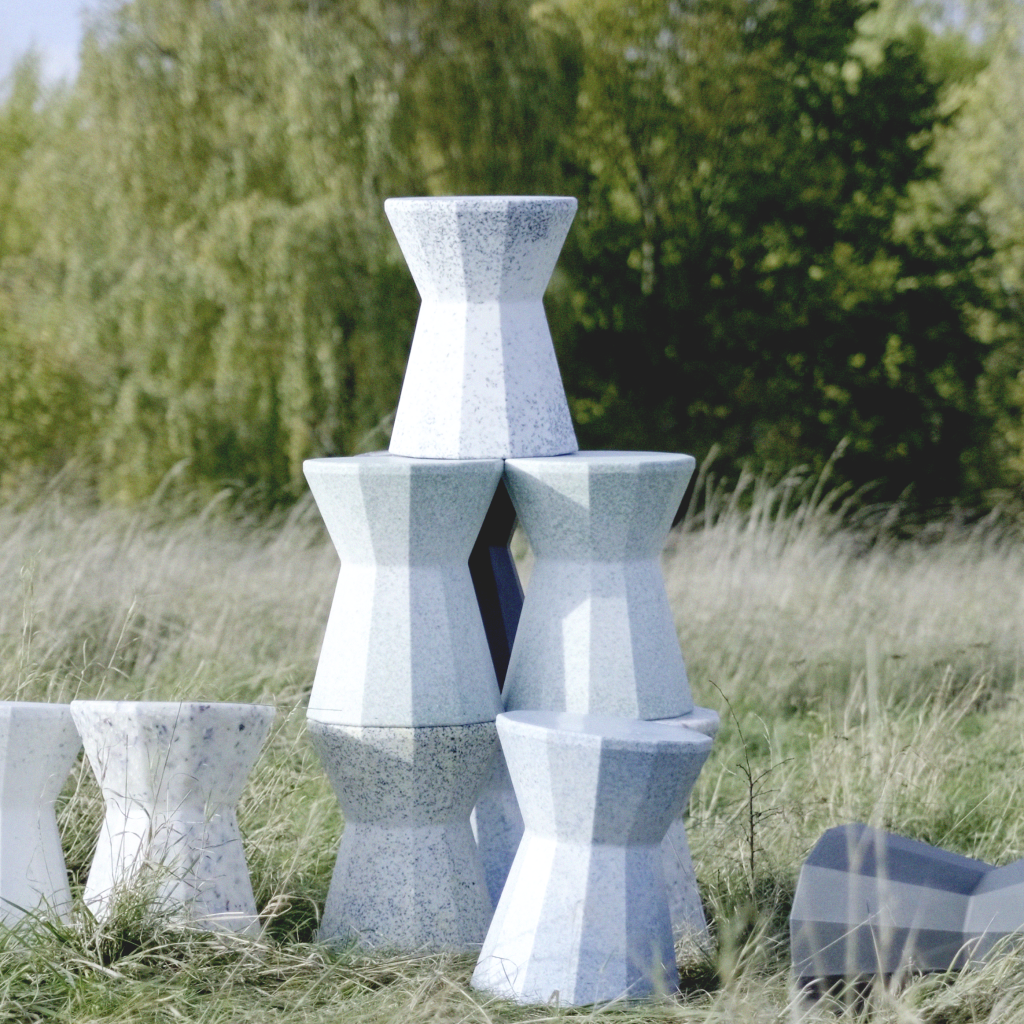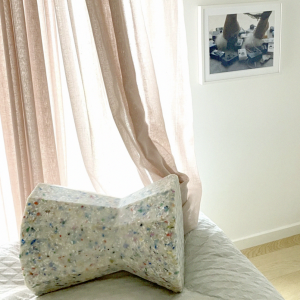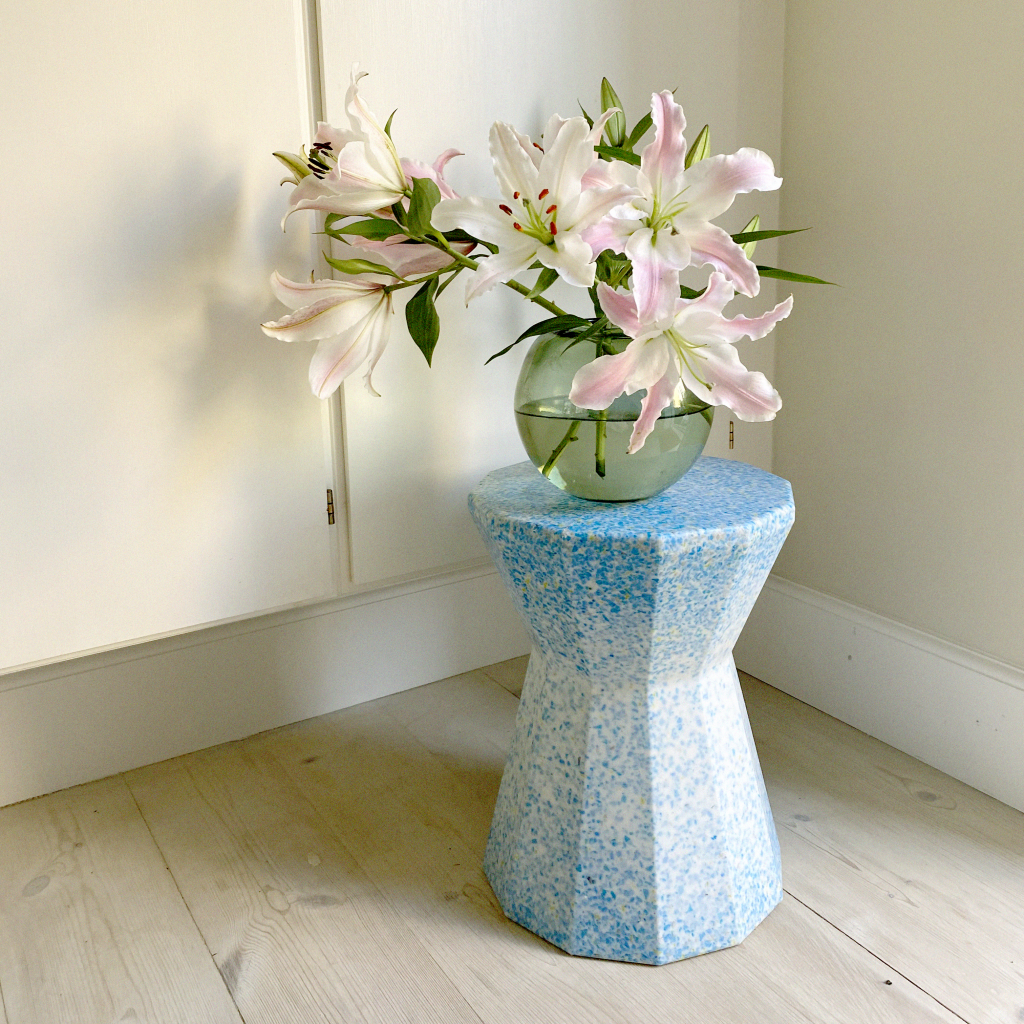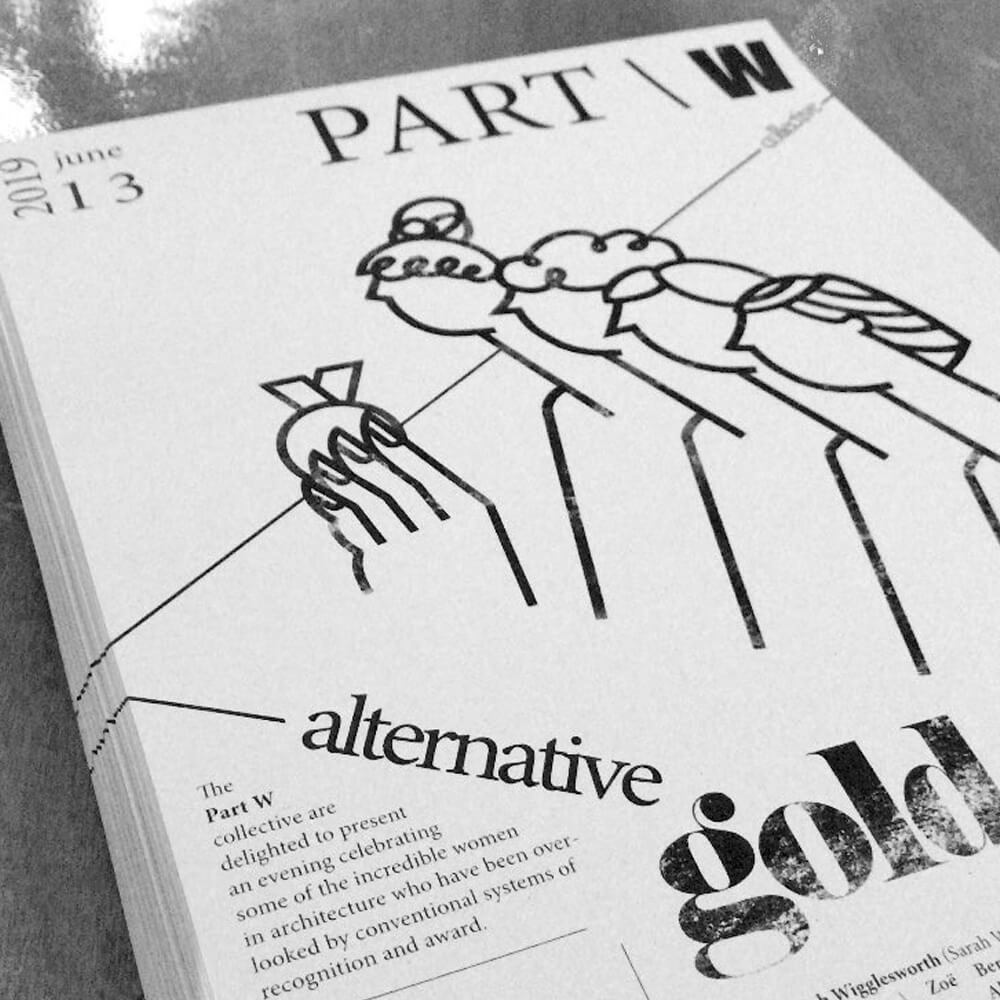SMALLrevolution Rethinks Sustainable Scandinavian Design

Few stop to think about where that water bottle they just threw out goes, or how long it’ll take for that takeout container to break down. Plastics remain to be a highly criticized material, and with good reason: the global population produces over 400 million tonnes of plastic waste annually.
However, few also know that plastics have the potential to be recycled up to 5-7 times. Stumbling upon the world of recycled plastics, the women behind SMALLrevolution are helming a sustainable reinvention of what furniture can look like. Based in Copenhagen, SMALLrevolution sources anything from milk bottles to water bottle caps to create their signature speckled recycled plastic material. The resulting stools, vases and podiums break away from conventional Scandinavian design with a definite fun, feminine edge.
FRONTRUNNER spoke to Arendse Baggesen, founder of SMALLrevolution, about how the company got started, their sourcing process, collaborations with Ganni, and why we need a sustainable revolution now.

Tell me about how SMALLrevolution started. What inspired you to create this brand? I know that Mie is a visual artist. How does this background influence your designs?
Sure. We started SMALLrevolution in late 2019. We were four women on board in the beginning, and then we actually had a different focus than what we started with. We focused on urban development and how to create feminine landscapes and urban spaces, because especially here in Scandinavia, the urban planning is very masculine, and always is about how to get from A to B. Because we had to find a material to back us up, we quickly got to know plastics and recycled plastic. Immediately, when we discovered recycled plastic as a material that hasn’t been used and developed, we were just hooked. It’s like, OK, this has huge potential. This is so crazy that there’s no one working with recycled plastic, and even more crazy that recycled plastic has such a huge sustainable potential. It can be recycled up to six and seven times. From there, it actually took off quickly; it developed into a sustainable recycled plastic company instead of an urban feminine company. With that new focus, the two other founders stepped out of the company, and then Mie and I had the ability to just focus on this agenda. So the designs are very much based on the capabilities of the material. This is the focus for all of our designs: how can we push the material and what are the possibilities with it? It’s not just the form, it’s not just the function of the material all the time. So what are the potentials of that?
I’m just curious, did you have any prior knowledge of recycling processes, and just in general, how do you develop the different materials? How do you get the different kinds of aesthetics out of the plastics?
So in our early processes, we got really hooked on visiting garbage and waste managers in Denmark. We had many months in the beginning where we just traveled around and visited waste managers and saw the different colours and asked all the stupid questions like “what type of plastic is this” and “how does it match” and “how does it match with other plastic types” and “how do we ensure that it’s actually recyclable and recycled again”. Mie and also one of the other founders have the aesthetic look and [know] visual cues, [being] a visual designer and visual artist. So Mie definitely knows how to put colours together. But to be honest, none of us had the background as recyclers or any knowledge in that. It’s very much driven with the focus of how we can make an impact, and understanding that we have to make an impact in this industry. There hasn’t been a lot of development in the plastic industry yet, and this is definitely the time to do it. I think it’s just a matter of what colours are available to us and in that way, trying to bring the aesthetics together in the products.

On your Instagram, it says that sustainability, circular production and beautiful design are key elements of your company. I know that you kind of discussed this already, but how do you use your own personal style in terms of feminine urban planning and design while also keeping your commitment to the environment?
It’s always a really difficult balance trying to grasp all of it. I think our perspective is that being of course, female founders, that’s one aspect. We always have a focus on our products when we design them, that they are more organic and that they are more chunky and holistic. They don’t have the very typical Scandinavian design with all these sharp edges and not a lot of material. We really embrace that. It’s colourful and chunky and weird and our perspective is almost sexy, turning plastic into a sexy look. We just launched our three new products, three podiums. In choosing their names we decided that we wanted to engage our followers on Instagram and try to get a really good female name, because we already have three products and they all have female names. We wanted to continue that. It’s really important that we empower and that we celebrate all the women around us. So in that way, we still focus a lot on our feminine background and how we can take that into the company and our products. But in the main focus is the environment and how we can make a recycled impact, and that’s what drives us. That’s what we do every time we make a decision, like, OK, does this make an impact? Should we go this way or that way? Where do we make the most impact?
You just touched on the new series that you’re launching. It’s called Better Together. What’s the idea behind the new line?
The idea is exactly what the name is: that we’re better together. So it’s how we can raise up strong women in our daily lives. You can buy one [piece], just like you can have one good friend or a really strong mom. But putting us together, it’s much better. We can be stronger together. So it’s definitely a kind of position that’s a feminine perspective as well, that we have to embrace and empower our friends and women all around us. And we can be stronger and better when we’re together.

Something I noticed on your website is that you have different products for different spaces. You have your interior, your corporate and your public divisions. How did you select these different categories, and how is your design tailored to each of these spaces?
Yeah. So, to be honest, we actually started with the urban focus. All of our products are certified with an international playground certificate so they can actually be outside school grounds for all children. We started there and then COVID came along and we were like Shit! We have to do what all the municipalities and all of the institutions are doing, and just close down immediately. Then, the interior was just so obvious. We thought of beautiful products that could easily be used in homes and in bathrooms and stuff like that. So we tried Instagram and immediately, we got super positive feedback and we built a website in two days and a workshop. And then whatever we produced, it was sold immediately. The interior has just developed and grown a lot in one year, and now it’s our main income. All our capital, it derives from the perspective of the interior. The corporate side of our business is actually something that we are focusing on right now, especially with the podiums, with the new products and with Ganni being a super, super perfect partner for us, focusing on how we can actually create beautiful, quirky, fun products in recycled plastics. How can we show that recycled plastic can be fun and sexy and not always brown and a bit boring? So the corporate perspective is something we’re developing right now. And then when [society] opens up again, we will be totally ready for the Urban Development again.
Speaking of one of your clients that you mentioned, tell me about your collaboration with Ganni. How did you get into that? I know that you’re both Danish brands, was that kind of uniting factor?
Yeah, definitely. We were actually partnered up with Nikolaj in the spring, probably one year ago, and he’s the founder of Ganni. We were at that point where we were discussing business development and how to do a startup and stuff like that. And then he hooked us up with their interior designers. We immediately clicked with Stamuli, which is their interior design company. In that way, it was just a really nice coincidence for us that we had that first meeting with Nikolaj. That’s the thing about being a startup. It’s more luck that you actually meet the ones that could just escalate your growth in some way. We also had some really good discussions on how to be a startup with Nikolaj, but it’s definitely the partnering up with Stamuli that has been a catalyst for us.

Do you think that the objects that you create are tailored to a specific client – even just like a Scandinavian audience – or do you think that it’s scalable to an international level?
I think it’s super scalable. We can already feel that this is the way design has to go. There’s no other way but being much more sustainable and much more recyclable and with the focus on upcycling all of our materials that we need in our everyday lives. We can feel it, like we have clients in South Korea, we have clients in South America, we have places all over Europe and of course, mainly in Denmark. But it’s a matter of how quickly Mie and I can run our very nice and talented group of employees. Of course, there’s already competition. That’s just an aspect we have to work with. But our vision is in the future, we shouldn’t sell to South Korea, from Denmark. All of our production facilities, and all our plastic raw material is bought and produced in Denmark. That’s being done out of focus on keeping the value chain as local as possible, which was actually something that we decided in the beginning. But in an ideal world, we would have production facilities all over the world or in different regions. So that targeting the Asian market, we would go have production somewhere in Asia. Targeting the American market, we would have production somewhere in the US and so on and so forth. That would be a scalable solution in maybe three, four or five years that we will focus on.
What do you think is on the horizon for SMALLrevolution? What do you think is in the near future? Any projects or collaborations?
I think what’s really interesting right now is that we see companies and corporations that want to make partnerships with us where we take their plastic waste and then process it in our factories and production facilities, and then sell it back to the companies. So this is definitely one side that we will develop for the next 12 months. There’s so much to do in the field of traceability of plastics so that our clients know exactly where their products come from. We just hired an engineer and he will start that work. It’s not the focus on the product development, but more the focus on how can we actually create trackable and trustworthy QR codes and stories of our raw materials so that customers know what to do with it once it’s not a stool anymore or once it’s broken – what to do with the plastic. So we will definitely grow the more nerdy side of the company, where we can tell the story of recycled plastic. And then, of course, the international station; we have to figure out how to start up in the US and how to start off in Asia. Another side that we also actually work with right now is how can we create products that we need to have? Can we create refugee shelters in partnerships with the UN out of recycled plastic that we take from, let’s say, Bangladeshi refugee camps? Our production method is quite simple and it’s very easy to move it and build it up in Bangladesh, for example. So could we actually make products that are much more refined, and which is much more relevant than just being a stool or podium? And can we create water boxes, refugee shelters, something like that? So we keep having the designing side of our company, but we also need to develop a much more clever side.
That’s amazing. That’s something that we really need right now I think. Sustainability is definitely the future.
Exactly. Exactly. It’s the future. And we’re just getting started. In that way, it’s difficult being two women who are normally both working also in our jobs – before, we always started projects and stuff. So we love starting things. That’s a difficult side right now, that it’s just like, wow, there’s so much potential in this industry. There’s so much innovation that needs to be started in terms of recycled plastics. The focus is important right now.









Responses